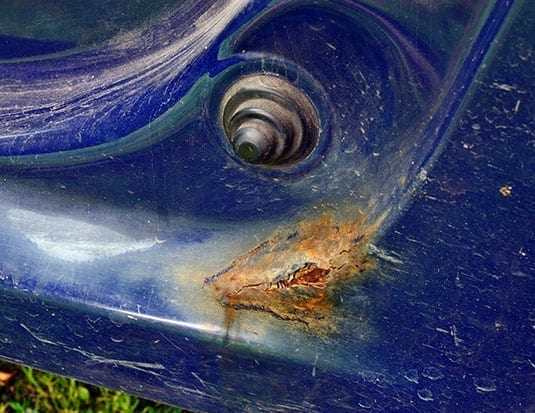Most people don’t consider that collision repairs are a common cause of premature vehicle corrosion.
When asked to identify the most prevalent causes of corrosion on vehicles today, the common responses are salt and corrosive chemicals, moisture or damaged coatings from stone chips. Most people don’t consider that collision repairs are a common cause of premature vehicle corrosion.
Consider that the minute your repairs are completed, the repaired areas are under attack by the corrosion process. If your shop is neglecting the often-forgotten step of applying a cavity wax to all newly welded areas you are inviting corrosion to attack your repairs causing lost repeat customers, or worse yet, allowing the vehicle to become unsafe as corrosion eats away at the vehicle structure.
“Collision centres must restore the corrosion protection to the same quality and durability that the manufacturer’s ecoat will provide. This means that everywhere the film has been compromised or removed, it must be replaced,” explains Patrice Marcil, Customer Experience Director,North America, Axalta Coating Systems, “even in hard to reach places like inner panels, rails or profiles.” Marcil adds, “The process is very similar for interior and exterior panels. Clean, prep thoroughly and apply protective film/coating. Exterior panels are easier for access but will require more finesse.”
Golden rule
“While refinishing a panel, a ‘golden rule’ to live by is to replace what you took off. Each paint layer applied by an OEM has a specific functional role in the battle against corrosion and longer-term durability.
Whether it’s the e-coat or basecoat etc., you need to rebuild this film to be able to perform to its original specification. The most frequent violation against this ‘golden rule’ is either by not using the proper product for the intended substrate or not applying enough material to achieve the proper film build, particularly in the primer and clearcoat stages, explains Hans Kempf, BASF Technical Training Manager, Automotive Refinish North America.
Proper sealers
Many refinishers are not treating exposed metal properly. If the e-coat is removed, it must be replaced with a material that acts with the same function as the e-coat itself. This means an etch or epoxy primer or alternatively a direct to metal (DTM) primer.
“Neglecting to use one of these products can compromise the resistance of the repair to the onset of corrosion. Poor corrosion resistance can also be caused by removing too much material in the sanding and polishing processes,” adds Kempf.
Cavity wax
At the factory, when welding is complete, the entire body structure is submerged in a bath of zinc phosphate, which saturates all the welded seams and provides ultimate weld sealing and corrosion protection. Obviously, the collision repair shop cannot duplicate this process, so they need to use the next best process to mitigate corrosion, which is applying a cavity wax after the parts are assembled and welded.
According to a recent 3M report, cavity waxes are designed to protect enclosed cavities such as frame rails and sectioned areas but also to seep in between the welded flanges to duplicate the factory chemical dipping process as closely as possible. A high-quality cavity wax should:
• Wick into tight gaps between panels
• Seal the gaps from the elements and encapsulate welding hot-spots
• Remain tacky and flowable
• Be self-healing by re-flowing into damaged or scratched areas
Most OEMs recommend the use of a cavity wax, which may also be referred to as an anti-corrosion treatment or agent, for collision repairs.



